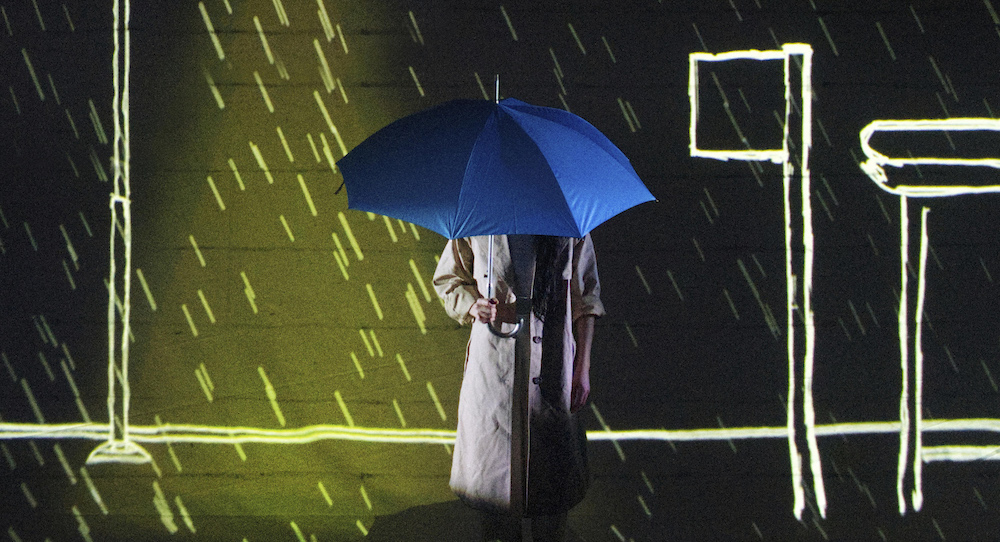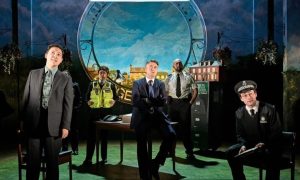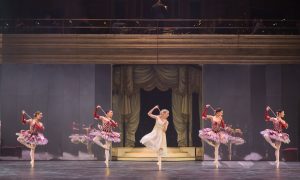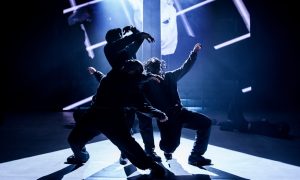Hackney Empire, London.
2 April 2025.
Following the world premiere at Edinburgh Festival Fringe, 201 Dance Company has been touring UK theatres this spring with Sad Book. ‘A personal story of loss. A father explores the disconnection between what we feel, what we show and how we deal with sadness.’
Interesting to note that due to the emotional nature of the production, a free-of-charge trained listener is on hand to talk privately with any viewers experiencing difficult or distressing feelings as a result of watching Sad Book this evening.
The opening scene of this one-act piece held the most powerful impact of the whole performance, relatable for all viewers who must surely have had experience of putting a happy face over a sad heart at some point in their lives.
A freezeframe of a birthday party – a long trestle table across the back of the stage covered in cakes, with the actor playing Michael Rosen – Alan Coveney – standing central and smiling tensely but broadly. Three dancers are on either side of him, dressed in non-descript beige clothing, in freeze-framed action poses eating and partying. Balloons, banners, tablecloth, all in beige. The rest of the stage is in darkness, and seated downstage right is Michael Rosen himself, holding the script of Sad Book from which he reads:
“This is me being sad. I’m sad but pretending I’m happy.”
This simple sentence carries so much weight. The words appear in white handwriting on the black backdrop, as though being written in a diary, and this continues throughout, as well as animated white line drawings resembling sketches and doodles that you might also find in a diary.
“Sometimes I want to talk about it, sometimes I don’t.”
Again, the relatability is so simply effective. Dancers on low stools behind Alan’s character Rosen, seated downstage left at a desk, act out his emotions, revealing his inner turmoil as Michael Rosen describes how his son died.
A particularly emotional scene is when the character Rosen, clutches a blue jumper to him, sobbing. Perceived to be his son’s clothing, the character Rosen, curls up on the floor with it. Then he removes his own outer clothing and stands under a spotlight as water rains down on him ‘screaming in the shower.’
Thought-provoking at the least, it was touching to watch the group of dancers – his emotions? – pick him up out of the shower and carry him gently overhead. They place him down by his desk and one of them lovingly pats his head and back dry with a towel; another removing excess clothing of their own for him to put on.
“There is a sad place inside me, because things aren’t the same.“
There is lyrical piano music, instrumental sections and more up-tempo parts that ebb and flow with the onstage emotions. Sound effects – wailing and screeching sounds – all add to the emotional journey.
There is some very effective visual movement from the dancers. More theatrical movement and action rather than dance a lot of the time; robotic walking across the back – going through the motions of life. ‘Fight of the mops’ as the dancers cleared up the water. Lighter moments, illustrating the natural rise and fall of our emotions.
“Sadness comes along and finds you.” A dancer lying on the floor twists and writhes uncomfortably.
Scribbles upon scribbles of words and crossings out on the backdrop. And a visually effective motion scene with the character Rosen walking centrally on the spot under an umbrella, and the animated backdrop of a town scene ‘moving’ with dancers coming the opposite way, also under umbrellas.
Like many people, the character Rosen thinks a lot during his walk, and what comes up after a while for him are happy memories of the times he shared with his son when he was alive.
One dancer with an umbrella performed a lyrical contemporary solo. More of this, with other dancers involved, too, would have been wonderful. Perhaps showing dance as a way to work through emotions, or even as illustration of the “clouds that come along and cover me up.“
She stood at the end of her dance piece and lighter patches began to appear on the backdrop, which led to a satisfying finish – back to the birthday party again, with the table laden with cakes. But this time, dancers, cakes, and decorations were in multi-colour. The character Rosen blew out the candles on his birthday cake.
“There must be candles.”
In the after-show talk, the host noted that Michael Rosen and Andrea Walker had ‘both created a world in which it is okay to be sad.’
This went down very well with the audience indeed.
By Louise Ryrie of Dance Informa.












